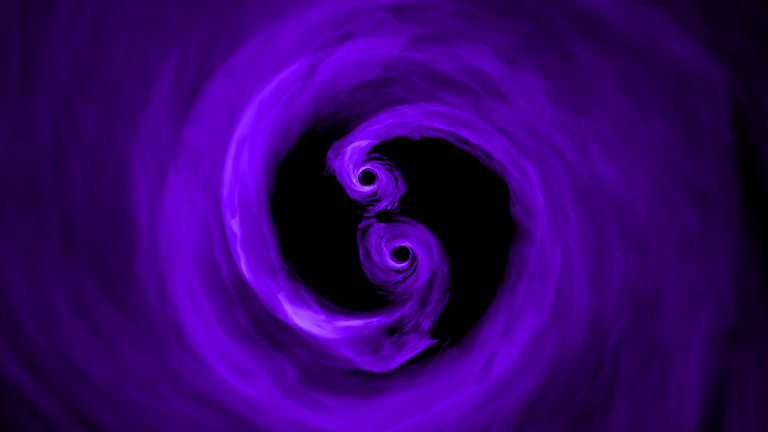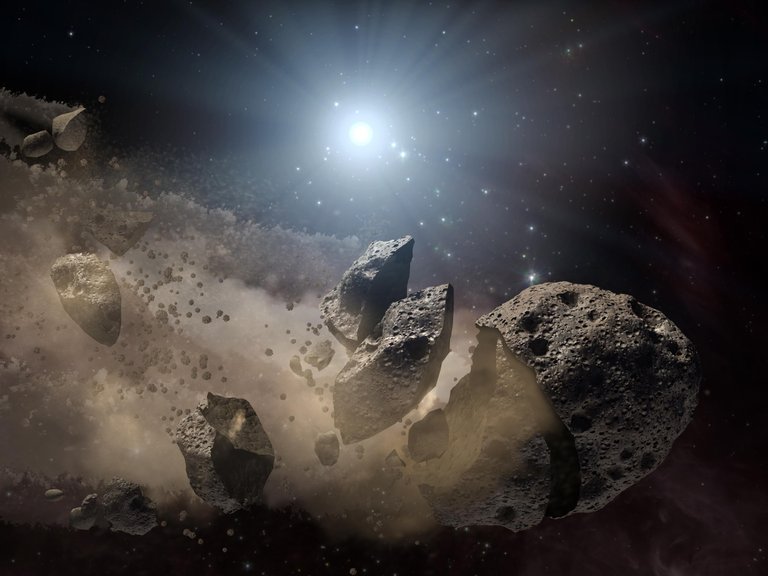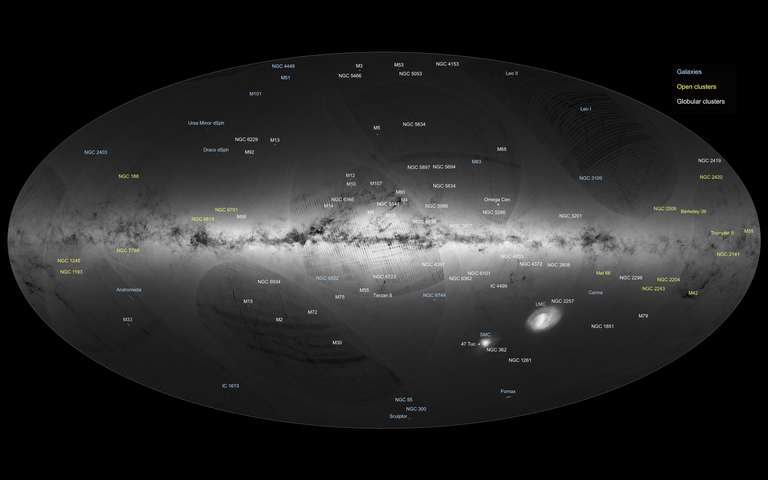Astronomy News #05 - Gravitational waves, black holes & star clusters
Completely random day - but perfectly aligned for another astronomy news post. Last week I stumbled upon various interesting and awesome news - highlights for me:
- For the first time, we managed to detect ringdown of two black hole mergers.
- Some supporting evidence that asteroids brought life on Earth
- New open cluster is discovered using Gaia satellite

In order to any of the next following lines make sense, first, we need to understand some basic things about gravitational waves.
For a few years now we are detecting gravitational waves regularly (note: graviton is still not confirmed) - takeaway from the last conference I visited, we are finally getting some science results other than detecting these anomalies in space-time.
How do gravitational waves form and what it is?
Gravitational waves are all disturbances in the space-time continuum, like every other wave we can use the analogy of perfectly smooth pond and throw a stone in it; it will create disturbance - ripples - which will propagate across the surface of the water all the way to the shore. A similar thing happens with gravitational waves, only in this case we need very massive objects to create big enough ripples that we can detect. Basically, whenever we have some irregularities with massive objects we expect waves to be produced.
Few examples:
- Perfectly spherical black hole all alone in the universe does not create gravitational waves.
- Perfectly spherical neutron star all alone in the universe does not create gravitational waves.
- A binary system consisting of two neutron stars or two black holes - or NS getting swallowed by BH WILL create grav. waves. (any binary system)
- Neutron Star with a bit of asymmetry and bumps on its surface & high spinning rate (angular momentum) WILL produce gravitational waves.
From 2015 11 sources of gravitational waves are confirmed, and since April 1, 2019, the new observational window is running with a current number of 28 candidates to be confirmed.
So we have two black holes, merging as they are getting closer and closer to each other they create ripples, more frequent and stronger. Once they merge there is a short period of time when waves are still produced while the mass is redistributing into a spherical shape - and then "silence".
There are nice ted talks on this topic - but some scientist transformed these gravitational waves into the sound - so you can check it here and get an idea of the things that are happening in these violent processes.
In the moment of collision, the waves are loudest - after that, they become fainter - scientist were sceptical that they would be able to detect this "ringdown" with the current technology, but they did and it is amazing discovery.
Again, General relativity was confirmed with another "control test" and no-hair theorem was confirmed at least for now.
No hair theorem says that black hols can be characterized by three observable parameters: mass, angular momentum and electric charge.
You can read more details and get a grasp how big this is reading sciencealert article or original research published in Physical review letters


Next one is about life on Earth - a topic which has a large number of theories and all of them have evidence both for and against it.
In the beginning stages, life on Earth was mostly based in the ocean. This study says that about 465 million years ago there was a massive collision in the asteroid belt (between Mars and Jupiter) creating enormous dust cloud in the Solar system.
With different materials in play and extreme atmospherical conditions, this most likely lead to an outburst of life which is also known as the Great Ordovician Biodiversification Event in the literature.
Schmitz and his colleague found dozens of fossilized meteorites but all of them carried a timestamp indication that dates back to 470 million years ago, which lead them to the conclusion that massive asteroid collision happened around that time.
They have interesting process of finding these fossilized meteorites:
How would you do it if you want to find a needle in a haystack?" Schmitz said. "It's quite easy: You burn the haystack away. And this is what we do." When your haystack is limestone, burning it means dumping it — 1,300 kg of it — into hydrochloric acid to eat away the rock, leaving chromite grains behind. "They survive everything," he said of the chromites. "They survive 500 million years in the sediment; they survive all our acid treatment."
You can read original paper here or check out the press release on space.com

New open cluster is detected in the Milky Way
Space telescopes and satellite stations are very important in Astronomy as they don't have to deal with all the atmospheric effects and interaction with the signal, as well that some wavelengths can only be seen from space.

Gaia satellite is one of these missions launched in space back in 2013 and expected to run at least until 2024, it's main goal is to observe stars and motions and map out as much as possible of the Milky Way.
With new data release team of astronomers found previously unknown open cluster. If you are not familiar with open clusters what is very important to remember is that all the stars inside the clusters are made from the same giant molecular cloud - It basically starts condensing towards one "proto-centre" but on the way starts clumping and splitting up, creating these nods that later become stars in a cluster formation.
With that in mind, all stars inside one cluster are relatively the same age and have very similar chemical composition.
This new star cluster consists of about 100 stars and is centred on Beta Lyrae (variable star which can provide important information on distance), and presents the heaviest member of the cluster.
"The scientific motivation for deeper investigations will, on the one hand, be given by the astrophysical interest in β Lyrae itself. Using precise multi-colour photometry in combination with high-quality spectroscopy of a small number of bright single-star members, or, for example, asteroseismology of just one or two bright members, can give solid estimates of the age and metallicity of the cluster. This, in turn, will provide a very useful asset for an improved astrophysical interpretation of the model binary β Lyrae and its kin," Bastian concluded.
A lot more details about this you can read in arXiv preprint, submitted to astronomy & astrophysics (A&A) jorunal.

Unlike previous articles, this one is a bit heavier with physics and astronomy stuff, but if you need any additional explanation feel free to spam the comments.
Cheers,
©Svemirac

Co-founder of Crowdmind project. Curie witness and crowdwitness operator. Proud member of steemSTEM community.
If you happen to have some free witness votes, don't be shy to cast on these ones, we are ranked as 68th and 17th respectively; as well as stem.witness.
pretty sure you made a typo. my eyes read star fuckers.
:(
!giphy spaceship
// You can support giphy by using one of your witness votes on untersatz! //
Off we go! :)
This post was shared in the Curation Collective Discord community for curators, and upvoted and resteemed by the @c-squared community account after manual review.
@c-squared runs a community witness. Please consider using one of your witness votes on us here
That's interesting. Especially the part about gravity and gravity waves creating ripples in space time. That's really neat. It's a challenging topic but It made sense to me the way you explained it. When the two black holes approach each other they cause more ripples through space until they combine as one, at which point things calm down again. That reminds me of two water vortexes coming together in a tub or river. I can totally picture that. Nice post!
Posted using Partiko Android
Exactly :) glad you caught the main idea.
It's interesting that we are usually explaining accretion disks (when stars and black holes eat stuff they create "sucking vortices" of matter) with tub vortices.
Cheers
Breathtaking.
I’ve not check in on NASA for a bit to see what they been up to.
I'll be bringing that up soon, maaaybe :) :D :D
Good luck with that. I have no idea how we could directly observe a graviton, its interactions being so gravitationally weak.
Thanks to a very nice alert system, any GW detection is accompanied by probes of cosmic ray, gamma ray or neutrino detection. We are in particular not supposed to detect yet any joint emission for what concerns the merging of two black holes (no sensitivity yet). However, seeing something may be extremely important as it may shake our understanding of what is going on there.
Yeah it would be so hard to see it - especially from the ground-based detectors. But given enough time, there is always a chance that something strange occurs - and Nobel prize goes to a lucky observer(or will be taken away from him). :D
I have heard rumours (which I won't make more explicit on chain :D ) and I am looking forward for the first public results of the O3 GW run!
Oh my, tell me more, tell me more! :)
With all the new boosted instruments its definitely nice time to be in the field of science once again. :)
Industry sucks anyways :P :)
This post has been voted on by the SteemSTEM curation team and voting trail. It is elligible for support from @curie and @minnowbooster.
If you appreciate the work we are doing, then consider supporting our witness @stem.witness. Additional witness support to the curie witness would be appreciated as well.
For additional information please join us on the SteemSTEM discord and to get to know the rest of the community!
Thanks for having included @steemstem in the list of beneficiaries of this post. This granted you a stronger support from SteemSTEM. Note that using the steemstem.io app could have yielded an even more important support.